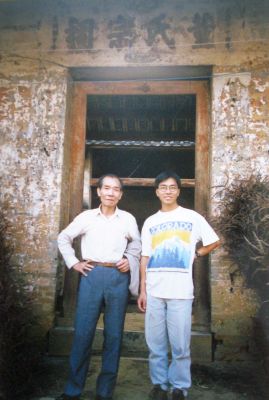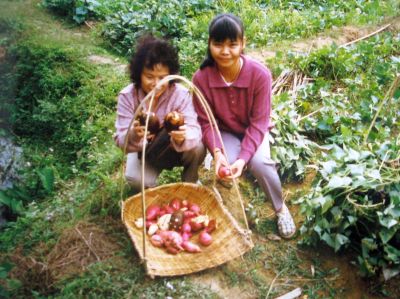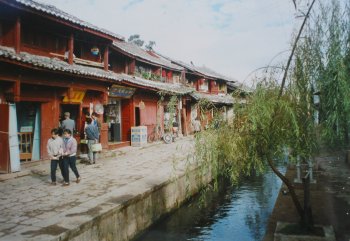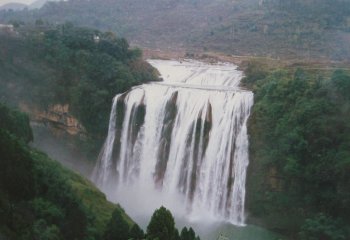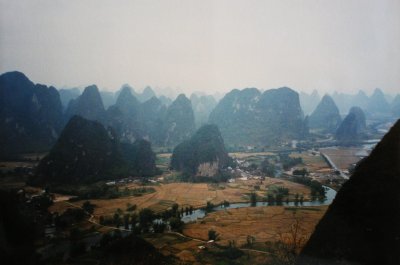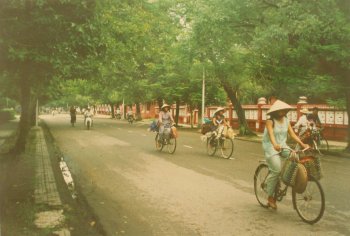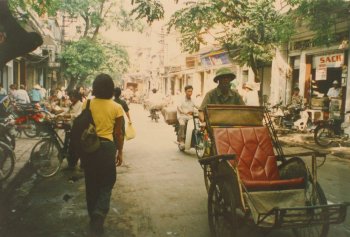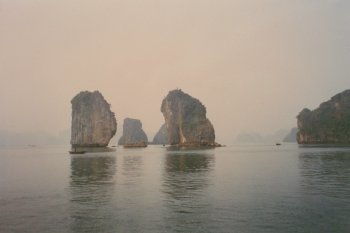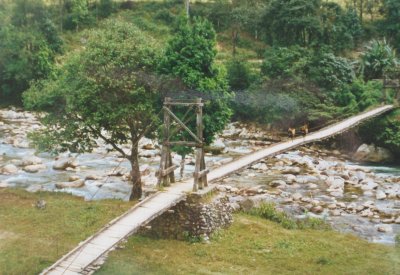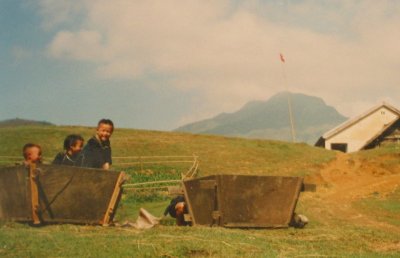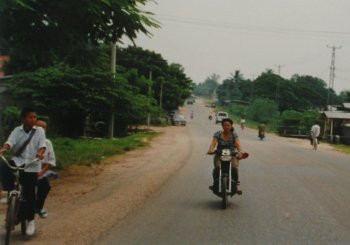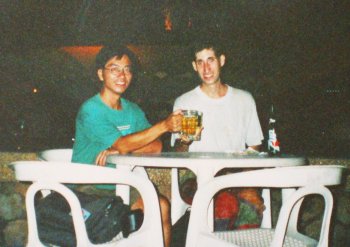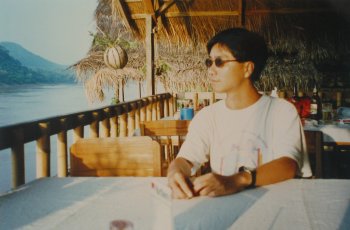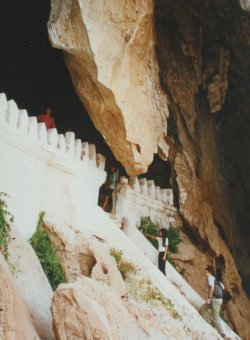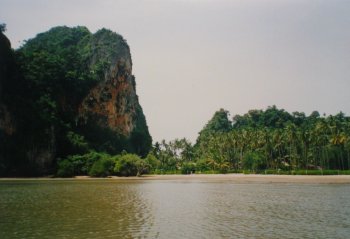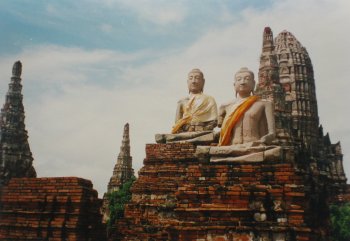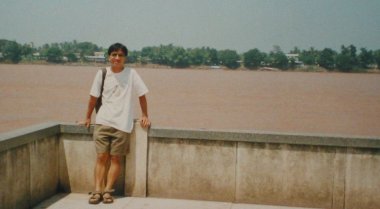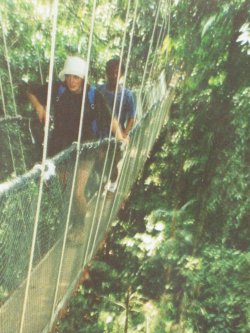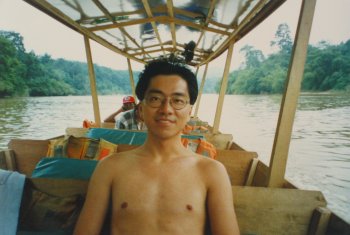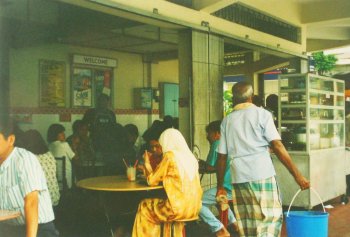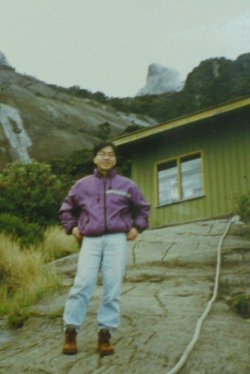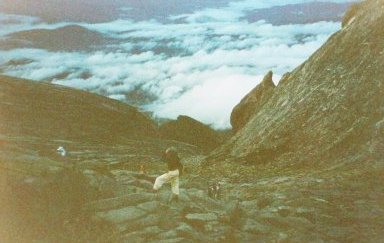Yunnan 云南
From the border town Hekou, I took an overnight train to Kunming, the capital city of the Yunnan province. Unfortunately the sleeper tickets have already sold out. So I have to sit tight in the hard seat coach for 16 hours. Fortunately this train was not crowded and it turned out to be not as tough as I expected. This section of railway is one of the most scenic routes people ever built. The train twisted slowly along the beautiful canyons, going through many bridges and tunnels in this mountainous terrain. I was marveled by the scenery until the night has fallen.
The train pulled into Kunming station at 6 am. It was still an hour before dawn and the temperature was very chilly. Indeed it has remained gloomy and cold for rest of the day. From Kunming I have planned to first take a detour to the west to see the ancient cities of Dali and Lijiang, then return here and continue the eastward journey on to Hong Kong. The overnight bus connection to Dali would not leave until the afternoon. So I have spent the few hours of layover wandering in the city, changing money, making phone calls and shopping. Yes, shopping! The city seemed to have an amazing array of consumer goods available at rather low prices. Over the years, China has come from a country of scarcity to become the new shopping paradise!
In Kunming, I have first experienced the developing country's cultural shock, the squat toilet! Once I got off the train, I went to the train station's busy public toilet. What I saw is basically a common trench with compartments partitioned by low walls on top of it. In the trench were many days of deposits accumulated. After traveled for a full day without using the toilet, I was in no position to object. So I did what I have to do - quickly! This was the initiation of what I would accustom to for my next two weeks in Yunnan. Only until I arrived in Guangxi would I see a flush toilet again.
1996.10.26
Dali 大理
It was cold and rainy in Dali when the bus dropped me off at dawn. The young attendant was still asleep when I arrived. I woke them up to check in. It was a nice and relaxing place with a large garden, pavilions and a Thai style bistro. The rate is only US$1.25 per person. It is certainly one of the cheapest place I have stayed.
The ancient Dali was once the capital of the Dali kingdom in the southwest China. Today it is a small town with charming old houses and cobble stone streets. It is beautifully situated with the Erhai Lake in the front and the Cangshan Mountains at the back. There is a tourist street where you can find cheap hotels, street side cafés and handicraft shops. There are so many tourists strolling up and down that locals nicknamed it "Foreigner's street". Also interesting is the market in the nearby town Shaping. The market is held on Monday in a large open area. They sell everything from grains, meat, cooked food, cloths to handicrafts.
I climbed the Cangshan Mountain to visit the Zhonghe temple. Unbeknown to me, a new cableway has constructed to bring tourists from Dali to the mountain. Indeed the cable lift sometimes passes directly over the hiking trail so that I could overhear the conversation from above. Zhonghe temple itself is a neglected little place at the cableway's terminal. Perhaps more interestingly is a foot path I found that extends in both directions across the mountain. The stone path is craved from the cliff and passes through many gorges and waterfalls. From there you will find a panoramic view of Dali and the Erhai Lake. I spent half a day exploring the path, which seems to go on as far as I can see. Then I came down by the newfound cable lift. The slow ride down affords a great view of the area.
The other day I have rode a bike to Erhai Lake and Xiaguan at the far end of the lake. It was a bumpy 3 km ride to the shore by a cobble stoned road. The ride was really not worth it as I find the shore a rather unattractive place. Luckily the rest of the trip was very good ride on a newly paved road run parallel to the main road. In Xiaguan I found the Erhai Park a pleasant place. It has an open view to the lake and the mountains. The spaciousness is a great relief to the crowded cities.
1996.10.30
Lijiang 丽江
The ancient city of Lijiang is in a valley floor amid the rolling mountains of Yunnan. Its well preserved old town is a real gem with old houses and cobble stone streets and a market square in the middle of the town. Open streams crisscross the city. People draw water for drinking and washing from these fast flowing streams. It seems surprisingly clear considers it is used by so many people.
The city has experienced a major earthquake earlier this year. People have spent an unforgettable Chinese new year camping outdoor in snow after the quake because of the danger in a damaged buildings. Although many buildings have already been restored, others were simply marked for demolition.
My bus from Dali to Lijiang ran thought a mountainous area. It has run into an unexpected problem and has broken down halfway amid the mountains. The driver flagged down a bigger bus for us. Despite it was already full, all of us managed to squeeze in somehow. When I finally arrived in Lijiang, I was again greeted by rain. Fortunately the weather was fine after that.
I stayed in the Lijiang hotel. The hotel has a shiny new wing used mainly by Chinese visitors. Foreign backpackers and myself, however, choose the old fashioned, communist style, blockish old wing. The dormitory I have stayed has 30 beds spread in a large hall. But it was only occupied by a few people. Other than the Karaoke music from the neighbor which went well into midnight, the dormitory is really not a bad place to stay.
Many inhabitants of Lijiang are of ethnic Naxi. They have developed an interesting looking pictographic written language called Dongba script. Many shops in the old town used it for their shop's sign. I also attended the performance of the Naxi music orchestra. The performers are mostly elderly over their 70s. The conductor Xuan Ke was a humorous man. He told stories in both Chinese and English of how they suffered and survived in the Cultural Revolution. He is very proud of his orchestra for preserving the ancient Tao music, which has originated but has since lost among the Han Chinese.
I had a great bike trip to Yunshanping, a plateau at the foot of Jade Dragon Snow Mountain (玉龙雪山), about 30 km away from the city with a steep climb. The weather was beautiful. Riding a lone bike along the lone road, I saw only shrubs and pine trees on this vast plateau. I love the emptiness and the solitude there. So there was quite an irony when I saw a Chinese sign elected on the road, proudly proclaim that "We will develop this place and push tourism into a new era"! Unfortunately on my way back I ran into a strong head wind. So strong that it turned the thrill of running down hill into a labor.
The sight of Jade Dragon Snow Mountain, standing tall at 5500 meter, dominates the Lijiang area. But its elusive peak does not reveal itself easily. Even on the sunniest hour the peak seems always hidden in cloud. Sometimes I just sat in the hotel to stare at it, hoping for the last patch of cloud to disperse. But I had no luck to catch a glimpse even after an entire week there.
1996.11.07
Tiger Leaping Gorge 虎跳峡
Tiger Leaping Gorge is one of the deepest gorges of the world. From the top of the mountain to the roaring river below it is almost 4000 meter deep. There were few tourism infrastructures available and no vehicle access. A demanding trail of about 30 to 40 km passes through the gorge from the town of Qiaotou at one end to Daju on the other end. Most people spent an overnight in the Walnut Grove village in the middle. The trail is often subject to natural hazards like landslides. It was further aggravated by the recent earthquakes. The gossip in Lijiang gave many people a second thought if it is safe to go. Indeed the Japanese roommate in the Lijiang Hotel has just turned back from there midway because the trail was washed away by a major landslide. To go or not to go, I have struggled over it for a long time. At the end I am very glad that I have made it, for it is one of most majestic place on earth.
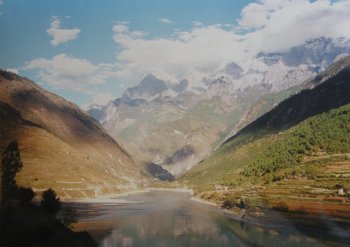
The bus departed from Lijiang was bumping on a bad road for a full hour before climbing over a mountain pass. From there it opens up to a great view of the Jinsha River, the upstream of the Yangtze River. The river makes the first bend at Shigu and then flow into the gorge. The bus continued rolling for another two hours on the winding road before it finally arrived in the grayish town Qiaotou.
I have spent a night at a pleasant guesthouse. Being the only guy I very much hope to meet other tourists for the trip. But Qiaotou is not like a national parks headquarter. Hardly any people seem to go there for leisure. By the time I set off at dawn the next day, it was clear that I was going to make the trek by myself. Only until half way would I finally met a villager. He was very kind and we joined for the rest the way.
* * *
At the entrance of the trail to Tiger Leaping Gorge is a toll booth. Funny how I have started so early that it was still not manned. So I just kept the 10 yuan toll. The trail begins with a long climb passes several villages. One thousand meter below my feet is the roaring water of Jinsha. On the opposite side is a vertical cliff of the back of Jade Dragon Snow Mountain. As I was progressing I looked back frequently and found myself getting deeper and deeper into the gorge. Finally I was deep enough that I could not see the outside anymore. Once I was on the trail I found the safety concern a bit overblown. It is no more challenging than any other trails I have been to, except of course this is in a very dramatic setting.
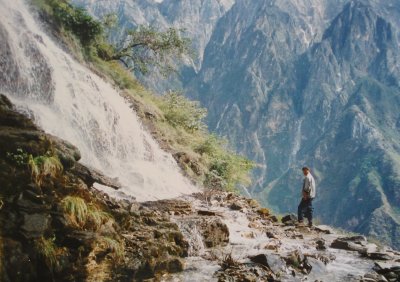
I have arrived in Walnut Grove by early afternoon. The small village in the middle of the gorge has two guesthouses. I was the only visitor in my guest house that day. The adult owner, who is also a farmer, was working in the field when I arrived. His 12 year old daughter was left to run the place and attended me. More visitors have arrived next day and place become livelier.
The guesthouse is fantastic. Outside is an outdoor café overlooking the cliff (in rural China's terms, an outdoor flat space with some rustic furniture). The village was small, quiet and peaceful, an enchanting place that fits Shangri-la. I realized how silly I was to be preoccupied with the physical challenge of trekking through the gorge. This village should be the destination! No longer was I concerned about completing the trek tomorrow. I just stayed in the village for an extra day. Actually I regretted to have packed ultra-lightweight and left many essentials in Lijiang in anticipation for a tough trek. Otherwise I would have stayed much longer.
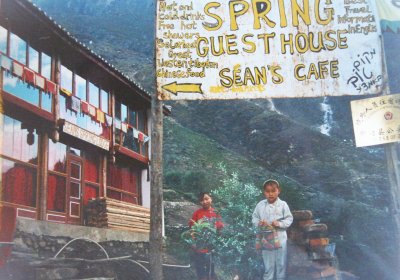
I have spent some time exploring the area. From the village I have descended to the river. It was not too difficult but it did involve some climbing over big rocks. Down there the powerful river was storming the boulders making thundering noise. I have also gone scouting with the guesthouse's owner, Sean, for an alternate route to Daju. The problem of that time was that part of a trail was destroyed in a landslide (that was the reason the Japanese friend has turned back). To bypass it, a detour was made by moving a boat crossing further upstream. Ironically the new crossing used to be an impassable rocky shallow. It has only become navigable because the landslide has dammed the river and raised the water level. This is the testimonial how the nature continues to shape the gorge. When we left for the next day, we have the distinction to be the first tourists to trek through Tiger Leaping Gorge by the new route since the landslide.
Reluctantly, I moved on by the third day. This time we were in a bigger convoy with the two girls I have acquainted plus the owner of the rival guesthouse. We descended to the water along a steep and zigzagging path. The descend route is actually one of the best place to appreciate the vastness of the gorge. We crossed the river by boat and then climbed back onto a plateau on the opposite side. Looking back, the zigzag path appeared as a crack on a vast cliff face. Here we have already exited the gorge. The owner accompanied us as far as the opposite shore of the river. But the boatman was very kind to accompany us all the way out. It was another 2 hours of walk from the plateau to the village of Daju.
1996.11.04
Kunming 昆明
After two wonderful weeks in Dali and Lijiang, I went back to Kunming by bus. I stopped at midway in Dali to break up the long trip. I went back to my old favorite café to sip some coffee. While I have left for Lijiang for a week, I was delighted to found many old pals I first met one week ago were still staying in Dali. Later I left for Kunming by another sleeper bus. In the midnight the bus had a minor crash with a different bus. This resulted in a crack in our bus' windshield. It was a miracle that we get back to Kunming with only two hours of delay.
Kunming didn't give me good impressions on my second arrival. The bus spent much time in bad traffic in the morning before it was able to pull into the terminal. The first thing happened when I got off the bus was I stepped into a stagnant pond of water. The crowds and noises of the city were overwhelming to me. I escaped Kunming after staying only for one night.
After settled down in the hotel, I went to the West Hill for sightseeing. But after Dali and Lijiang, the sights in Kunming are pale in comparison. The West Hill does have a view of the Dian Lake, though it is no comparison to Erhai. The Taoist temple at the Dragon Gate and the tunnel craved in the cliff is a work of marvel. But there were just far too many tourists packed in a narrow passage for me to truly appreciate it. Chinese tourists go to sight seeing spots to pose for pictures. I was constantly getting in the way of pictures and they were not hesitated to ask me to make way.
Shilin (Stone Forest) is an area outside of Kunming famous for the many towering limestone spreading in the region. I have joined several others for a day trip by a shared taxi. Upon arrival I found Shilin almost like a theme park. The main park has so many improvements, like paths, railings and pavilions, built right amid the stones that it makes nature looks artificial. Loads of tourist are posing for pictures and making much noise. Even if I tried to get away in the labyrinth of pillars the noise echo around and reach everywhere. It made me wonder maybe I should not come at all. Fortunately Shilin is very large. All I need to do is to walk away from the main park. Further across the grassy field are several different groups of stones. There one will find no artificial improvements and no noisy tourists. Only then was I able to truly appreciate the Stone Forest as a natural wonder.
I returned to the hotel room in the late afternoon. Although I have already checked out in the morning I was sneaking back for a shower. My bed in the dorm room has already occupied by a new guy. But two previous roommates were still there. I had a good chat with the guy from Namibia before leaving. This conversation was perhaps my most positive experience in Kunming.
1996.11.09
Huangguoshu Falls 黄果树瀑布
My next destination Guilin is 30 hours away by train. The sleeper ticket was in such high demand that it was out of question to get it in short order. Hard seat ticket was still available. But rather than sitting 30 hours straight, I have decided to stop midway in Guizhou to visit the great Huangguoshu falls. This way the long trip was broken into two shorter legs that were less wearing.
The weather was again gloomy and rainy when the train arrived in Anshun station. The town does not look like an attractive place to stay. So I have decided my visit to Huangguoshu is only going to be a day trip and I would leave in the evening.
I often took advantage of overnight transportation to save on hotel expenses. This time I really pushed it to the extreme. Out of the four nights, three were spent on transportation. The first night on the bus from Dali to Kunming, then a night in a hotel, another night on the train to Guizhou, and this night on the train to Guilin. I have covered a long distance in a rapid pace. Yet I still managed to visit many major attractions on the way. If you ask me about shower, I have to say I did not have the opportunity to do it everyday.
I joined the minibus tour to Huangguoshu operating right in front of the train station. Being a rare Hong Konger makes me an interesting subject on this bus. Fellow mainlanders were very curious and asked me all sort of questions. They were particularly enthusiastic about Hone Kong's return to China in 1997. However they were disappointed that the border control would remain and they still cannot travel to Hong Kong freely after 1997.
Our first attraction in Huangguoshu is the Tianxiang bridge park. It has a stone path that leads us through a series of minor waterfalls and lakes. There were so many tourists that it just reminds me of the touristy part of Shilin. The only thing interesting is the cavernous cave that we went next. However I was bothered by the strong spotlights setup inside the cave, presumably to make photography easier inside. I suspected that is also the cause of high temperature and stuffy air inside.
We went on to the main waterfall in the afternoon. At 77 meter high and 77 meter wide, it is an impressive fall. Again there were many tourists there all busy posing for pictures. From above, trails and tunnels bring us to up close to the falling water. Finally a path leads us to cross the fall behind the water. I had fun, got wet, but somehow felt it was anti-climax.
* * *
From Huangguoshu I went to the Guiyang train station in the evening. When I saw the crowd outside the station, I knew I was getting in trouble. Although Guiyang is a major city on the busy Kunming-Guangzhou rail line, trains were all full when it arrived here. Not only was it impossible to get a sleeper ticket, I cannot any ticket at all. I braved through the crowd to reach the ticket window, only to find it mostly unattended. When the attendant occasionally returned, she only minded her own business and entirely ignored me asking question in front of the window. Desperately I turned to the only viable source, the black marketeers in the station. I paid them a few times over the official fare for a ticket. But that bothered me less than the risk of end up with a fraudulent ticket. Unlucky I managed to get on the train without problem. Like most major train stations in China, Guiyang station was busy day and night. The waiting room only opens for passengers whose train is about to depart. My departure time happen to be 1 am. That means I have a few hours to spend but no place to go.
By midnight I have managed to get on the train. My ticket did not come with an assigned seat. Just as I have feared, the coach was completely full. Facing the prospect of standing overnight and for all 18 hours of the trip, I was surprised to find out there were black marketeers trading seats too. Although they seemed to be dubious people, I still paid them for the privilege. All the time I have worried a rightful owner of the seat might turned up to challenge my right.
Once I settled in, the journey has only just begun. Sitting overnight was one thing; dealing with the awful hygiene and rough people was another matter. Passengers conveniently threw trashes like fruit peels and peanut husks straight to the floor. Spitting on the floor was prevalent and was practiced by all five passengers sitting around me. Every once in a while the attendants would sweep the floor and invariably it snowballed into a huge pile of trash. Verbal fights broke out among passengers from time to time. In the midnight I was awaken by the commotion because a thief tried to steal from a passenger asleep. Even as he was caught he has not backed down and it almost ended in a fist fight. What a tense night on a train!
Such is the time when being a solo traveler is especially vulnerable because you have nobody else to fend for yourself. I hold off using the restroom for the longest time because doing so would surrender my seat and no one was looking after my baggage. The time on this slow moving train seemed to last forever. I was counting hours and constantly trying to boost my spirit, reminding myself there will be the sunshine at the end of this.
1996.11.10
Yangshuo 阳朔
Finally I got off the train in Guilin and then transfer to another minibus for Yangshuo. It was rather late when I got there. But at last I have survived that awful trip. I checked myself into a decent hotel and was delighted to find that it has a flush toilet, something I have not seen for a long time. I treated myself a nice meal and a beer at a café before going to bed.
Yangshuo is a small town but it has a niche of foreign tourists. The tourist street is lined with roadside cafés and souvenir shops. Some cafés has evening movie shows for western movies. It reminds me of Bangkok's Khao Shan road except it is much quieter here.
The town is right on the Li River, where people go to see the famous Guilin scenery. The water is shallow but exceptionally clear. The Li River boat trip is a big tourist attraction. Along the river we saw all kinds of peculiarly shaped hills and rocks. These karst formations are actually abundant throughout the Guangxi province and Guizhou province. But on the Li River the sight combined with its reflection on the river forms a particularly poetic scenery.
The next day I planned to bike to the nearby Moon Hill. It is some distance from the town and the direction was sketchy. I have some doubt if I could find the place. But once I went out in the country I find it impossible to miss. The Moon Hill was out there on a wedge shaped hill punctured by a big round hole that gives it the name! I biked to the hill base, climbed to the hole and finally over to the peak of the arch above. Nobody was there and I have the hill all by myself. From the top it offers an excellent view of the area.
Yangshuo was essentially the last stop in my trip as a tourist. Although I do not have any commitment afterward, I have not lingered on any longer than the three days I have planned. Yangshuo is a nice place. But I did not have the same kind of attachment as I have found in other places. I was grateful for what I have seen and done so far. It was about time for me to complete the journey.
1996.11.14
2007.03.04 [travel, SE Asia 96] -
comments
